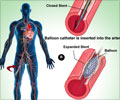Diabetes, atrial fibrillation, hypertension, and chronic obstructive pulmonary disease increase the risk of heart failure after the first heart attack.

‘Diabetes and hypertension increase the risk of developing heart failure after a first myocardial infarction by 44 percent and 16 percent respectively.
’





The Risk factors included older age, greater socioeconomic deprivation, and co-morbidities such as diabetes. "Heart failure is a major medical problem with a high chance of hospitalization and death," said Dr Gho. "Patients with ischemic heart disease are at the highest risk. This includes those who have had a myocardial infarction, also called a heart attack."
He continued: "Research studying incidence of heart failure following myocardial infarction is limited and mainly stems from the thrombolytic era, when drugs were used to dissolve blood clots. Today the preferred treatment for acute myocardial infarction is a percutaneous coronary intervention (PCI) where a stent is used to open the blocked artery."
The current study used prospectively collected electronic health records to investigate the contemporary incidence and risk factors for heart failure after a first myocardial infarction. "Finding which heart attack patients are most likely to get heart failure would help us target preventive therapies," said Dr Gho.
The study used data from the UK-based CALIBER (Cardiovascular research using Linked Bespoke studies and Electronic Health Records) program. Primary care records were linked to hospital admissions and national registries on myocardial infarction and mortality.
Advertisement
During follow-up, 6005 (24.3%) patients developed heart failure. Dr Gho said: "Around one in four patients developed heart failure within four years of a first myocardial infarction in the current era. This was relatively stable over time possibly due to two competing trends. On the one hand, PCI has improved treatment for myocardial infarction so the risk of heart failure would be expected to decrease. On the other hand, because treatment has improved, more patients are alive after a heart attack to subsequently get heart failure."
Advertisement
The following conditions were associated with a higher risk of developing heart failure after a first myocardial infarction: diabetes (44% increased risk), atrial fibrillation (63% increased risk), peripheral arterial disease (38% increased risk), chronic obstructive pulmonary disease (28% increased risk), ST elevation myocardial infarction at presentation (21% increased risk), and hypertension (16% increased risk).
Dr Gho said: "Previous research looking at all cause heart failure, not only after myocardial infarction, has found similar risk factors. Our large cohort study confirms that these are also risky conditions for heart attack patients in the current era."
He concluded: "Identifying these prognostic factors in heart attack patients could help us predict their risk of developing heart failure and allow us to give treatments to reduce that risk."
Source-Eurekalert















